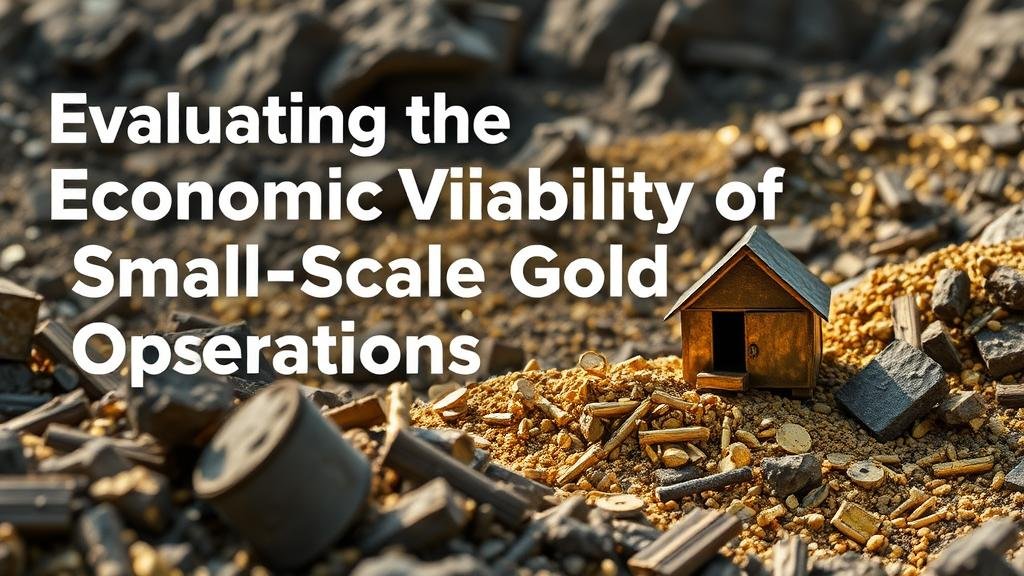Evaluating the Economic Viability of Small-Scale Gold Operations
Evaluating the Economic Viability of Small-Scale Gold Operations
The small-scale gold mining sector has gained significant attention in recent years, particularly in developing countries where it serves as a vital source of income and employment. But, evaluating the economic viability of these operations requires careful analysis of various factors including costs, market dynamics, and regulatory frameworks. This article discusses how to systematically evaluate the economic viability of small-scale gold operations.
Understanding Small-Scale Gold Operations
Small-scale gold mining typically refers to operations that produce less than 100,000 ounces of gold annually. e operations often utilize simple and inexpensive mining techniques, making them accessible to local miners.
- Artisanal mining: Small groups of miners work independently or in informal groups.
- Small-scale mining: More organized operations that may have limited mechanization and adhere to certain regulations.
A clear understanding of these definitions helps set the stage for evaluating their economic viability.
Cost Analysis
The first step in assessing economic viability is conducting a thorough cost analysis. This involves evaluating both fixed and variable costs associated with the operation.
- Fixed costs: These include equipment purchases, land leasing, and initial setup costs. For example, a small-scale operation may require an initial investment of $50,000 for basic equipment such as sluices and excavators.
- Variable costs: These costs can fluctuate based on operations and may include labor, fuel, and maintenance. On average, labor costs can range from $15 to $30 per day, depending on the region.
Also, managing financial risk is crucial. Mining operations often face unexpected expenses due to equipment failure or regulatory changes, which can hinder profitability.
Market Dynamics
Understanding the gold market is essential for evaluating economic viability. Small-scale operations are highly susceptible to price fluctuations influenced by global markets. For example, data from the World Gold Council indicates that gold prices can vary significantly–averaging around $1,500 per ounce in 2020 but reaching highs over $2,000 in 2022.
The impact of these prices on small-scale operations is substantial; therefore, miners need to be prepared for variability. Economic viability is often hinged on a threshold price point where operations remain profitable.
Regulatory Considerations
Legal frameworks governing small-scale gold mining can significantly affect economic viability. Regulations vary by country and can impact operational costs and practices. Compliance with local laws may incur additional expenditures.
- Permitting and Licenses: Obtaining the necessary permits can be both time-consuming and costly, with fees ranging from $1,000 to over $10,000 depending on the jurisdiction.
- Environmental Regulations: Compliance with environmental guidelines can necessitate investment in sustainable practices, which, while beneficial in the long run, may increase initial capital expenses.
Case Studies
To illustrate the economic viability of small-scale gold mining, several case studies provide insight into real-world examples.
Example: Ghana
In Ghana, small-scale mining operations contribute significantly to the economy. A report by the Ministry of Mines indicated that small-scale miners produced over 1 million ounces of gold in 2021. By implementing cooperative mining models, some groups have reduced costs by pooling resources, demonstrating enhanced financial sustainability.
Example: Artisanal Mining in Colombia
In Colombia, artisanal miners face challenges due to illegal operations and the lack of regulation. But, initiatives to formalize these operations have shown promise. By providing training and access to finance, these initiatives have led to increased productivity and income for local miners, thereby improving their economic viability.
Conclusion and Takeaways
Determining the economic viability of small-scale gold operations requires a multifaceted approach that incorporates cost analysis, market dynamics, and regulatory compliance. Operators must stay informed of current gold prices and local regulations while also considering innovative solutions to financial and operational challenges.
- Conduct thorough cost assessments to identify fixed and variable expenses.
- Stay informed about market trends to anticipate price fluctuations.
- Understand and comply with local regulations to avoid penalties and enhance operational legitimacy.
By applying these strategies, small-scale gold miners can improve their chances of achieving sustainable profitability in a fluctuating economic landscape.


